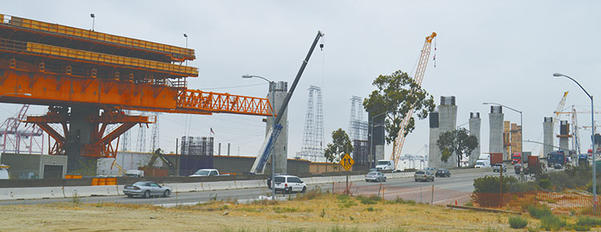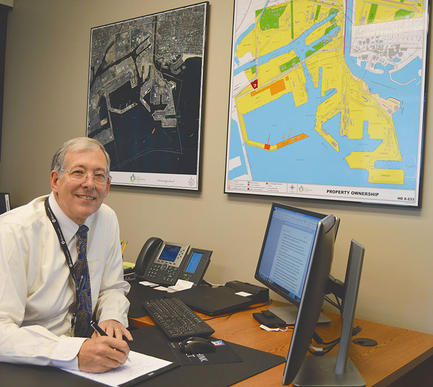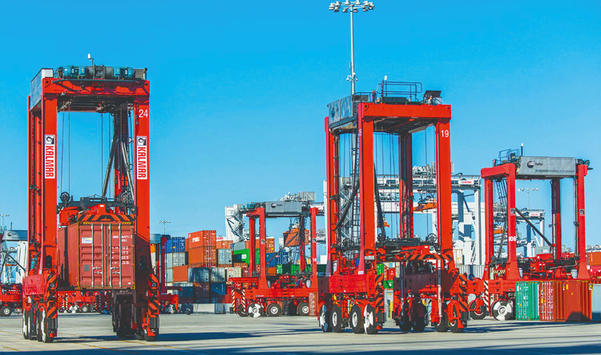From a towering new bridge to the installation of automated, clean-running equipment and the build-out of additional rail capacity, the San Pedro Bay ports are investing millions of dollars into upgrading their facilities on a daily basis.

The Port of Long Beach is in the midst of a years-long project to replace the Gerald Desmond Bridge. The new bridge is being built alongside it. Its columns and towers have already surpassed the height of the existing bridge, and a moving scaffolding system has completed three segments of one of the bridge’s approaching ramps. The new structure is being built higher to let larger vessels pass beneath it. (Photograph by the Business Journal’s Larry Duncan)
Perhaps the biggest driving force behind these investments is the advent of mega-ships – vessels as long as the Empire State Building is tall. The dual port complex is now on the regular schedule of ocean carrier CMA CGM’s fleet of vessels able to carry 16,000 twenty-foot equivalent units of cargo each – the largest ships to ever call U.S. ports. Projects at both ports involve installing larger cranes and raising existing ones, deepening water and expanding cargo capacity to be able to accommodate these ships.
While bigger ships don’t necessarily translate to more cargo overall, it does mean much more cargo arriving at one time – a recipe for congestion, as both ports have discovered in recent years. The automated equipment and rail expansion projects at the ports are designed to help alleviate some of that congestion.
Port Of Long Beach Projects
Entering the port complex from any direction, it’s now impossible to miss the rising towers and columns for a new bridge over the Port of Long Beach. The future structure is replacing the existing Gerald Desmond Bridge directly adjacent to it, and its columns are already starting to tower over the smaller bridge.
The design for the cable-stayed bridge includes three lanes each for westbound and eastbound traffic, as well as a bike path and pedestrian walkway named after the late Mark Bixby. The bridge’s support towers will rise 515 feet above the waterline, making it the tallest structure in Long Beach. To allow larger vessels to pass beneath it, the deck will have a clearance of 205 feet above the water. The existing Gerald Desmond Bridge has a 155-foot clearance.
“The towers are now taller than the existing bridge. Those are fantastic,” Duane Kenagy, the port’s senior executive lead overseeing capital projects, told the Business Journal. At this stage of construction, they are taller than 200 feet.
“This is a bridge of firsts: it’s the first cable-stayed vehicular bridge in California,” Kenagy said. “It’s obviously constructed in a dense port-operating environment, so that creates a lot of challenges. But we’re working through those issues.”
Due to unforeseen issues and some design changes, the project budget has been adjusted multiple times. The last increase was about a year ago, bringing the total to $1.467 billion. “That budget is holding, so we’re within the revised budget,” Kenagy said.
“We’re basically at the midpoint of construction now in terms of what’s been built,” Kenagy noted. A mobile scaffolding system is being used to construct the west approach of the bridge without traditional wooden scaffolding. The equipment inches along above ground, supported by the new bridge’s columns, to build the deck.
“The contractor has successfully built the first three segments of the west side approach using the mobile scaffolding system. . . . They’re now working on the fourth segment,” Kenagy said. A second mobile scaffolding system to build the east approach of the bridge is set to arrive in the next month or so, he noted.
The westbound lanes are set to open before the eastbound lanes, so for a while traffic will flow on both the new bridge and the old one. “We’re now projecting that we’ll have traffic both directions on the bridge by the end of 2018,” Kenagy said.
The second phase of the Middle Harbor Redevelopment Project is also underway at the Port of Long Beach. The project involves combining two aging terminals and equipping them with electric, automated equipment built to handle the largest ships in the world.
The first phase was completed in April, and the tenant, Long Beach Container Terminal (LBCT) – a division of Orient Overseas Carrier Line – is now in business. The facility features taller, automated electric cranes, automated guided vehicles for cargo movement on the docks, and deeper water at berth.
Phase Two of the Middle Harbor project involves expanding the terminal’s wharf, container yard and intermodal rail yard, Kenagy said. The container yard expansion is currently under construction, he noted. A new administration building for LBCT, which will be built to meet LEED (Leadership in Energy and Environmental Design) standards, as well as a new southern gate entrance, are also planned.

Duane Kenagy, capital programs senior executive lead for the Port of Long Beach, oversees all the port’s capital improvement projects. The two largest ongoing developments are the Gerald Desmond Bridge Replacement Project and Middle Harbor Redevelopment Project. (Photograph by the Business Journal’s Larry Duncan).
“We do have some schedule issues,” Kenagy said. “We’re working through those with LBCT and working on completing the project as close to the original schedule as possible.”
There were some “lessons learned” in the development of the first phase of Middle Harbor that might shift plans for the second phase, according to Kenagy. For example, a second battery exchange building – a facility where the batteries for the automated guided vehicles are recharged and replaced – might be built. Although the first building is completed and was meant to serve the whole facility, another might be necessary, he explained.
The Middle Harbor Redevelopment Project should be finished by the end of 2019, Kenagy said. Until then, it’s responsible for generating 1,000 construction-related jobs. When both phases of the project are live, 14,000 more jobs are expected to be created by the additional trade the facility will accommodate, according to a port spokesperson. The Gerald Desmond Bridge Replacement Project is generating about 3,000 construction-related jobs.
Aside from these two massive endeavors, the port has 200 capital projects underway, ranging in scope from a small utility upgrade to new fireboats, the expansion of a rail yard at Pier B and the new port headquarters in Downtown Long Beach.
Port Of Los Angeles Projects
The Port of Los Angeles (POLA) also has two major capital improvement projects underway, both of which aim to upgrade and modernize port terminals to accommodate larger ships.
The expansion project at the TraPac terminal is the larger of these projects, with the port’s share of investment totaling $510 million, according to Tony Gioiello, chief harbor engineer for POLA. About 80% of the project has been completed, including the installation of electric, automated equipment similar to that implemented in the first phase of Long Beach’s Middle Harbor project, he noted.
“It’s fully automated, pretty sophisticated stuff,” Gioiello said. Longshore workers are still operating the cranes that move cargo from ship to shore, but the stacking cranes that move the cargo on the dock are fully automated, he explained. The terminal also has automated guided vehicles to deliver containers from stacks to trucks.

The TraPac terminal at the Port of Los Angeles (POLA) is undergoing a modernization project. It has been outfitted with automated cranes and vehicles to move cargo around the dock. The equipment is all-electric. (Photograph provided by POLA)
About two months ago, the terminal’s intermodal rail yard was completed, and with it, the port reached a milestone – all of its terminals now have on-dock rail, Gioiello noted. “It was actually very critical for them to have an on-dock facility for a competitive advantage,” he said of the TraPac terminal.
The TraPac terminal project upgrades are being undertaken as part of a new 30-year lease with the terminal operator, Gioiello noted. Phillip Sanfield, a port spokesperson, said TraPac desired the improvements to stay competitive and be able to efficiently handle mega-ships.
The five-year TraPac project is on schedule for completion at the end of 2017 and is on budget, Gioiello said.
A smaller, $67 million project to upgrade the Yusen terminal is also underway at the port. The project involves deepening the water at berth to allow for larger ships, as well as strengthening portions of the berth itself, according to Gioiello. A larger crane is also being installed, he noted. That project, which began construction about a year ago, is on schedule for completion in 2018.
The port is wrapping up a $383 million transportation infrastructure improvement program this year. The program’s end goal is to reduce the impact of port truck traffic on public roadways. It includes the following projects: the South Wilmington Grade Separation, $72 million; Berth 200 Rail Yard Project, $120 million; and construction on various I-110 Freeway interchanges and connectors, $101 million.
The port recently committed to heavily investing in projects to benefit public waterfront spaces at the port, including $50 million for the revitalization of Ports O’Call Village in San Pedro and $52.7 million for the redesign of the Wilmington waterfront at Banning’s Landing. “Everything is in the design phase right now,” Gioiello said of the community projects.
